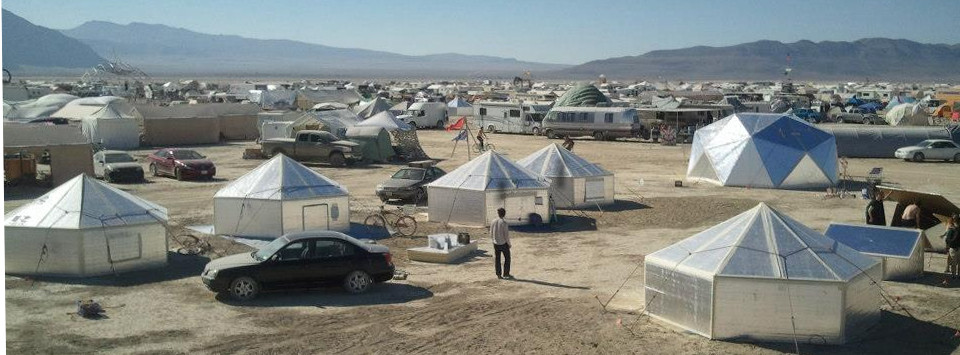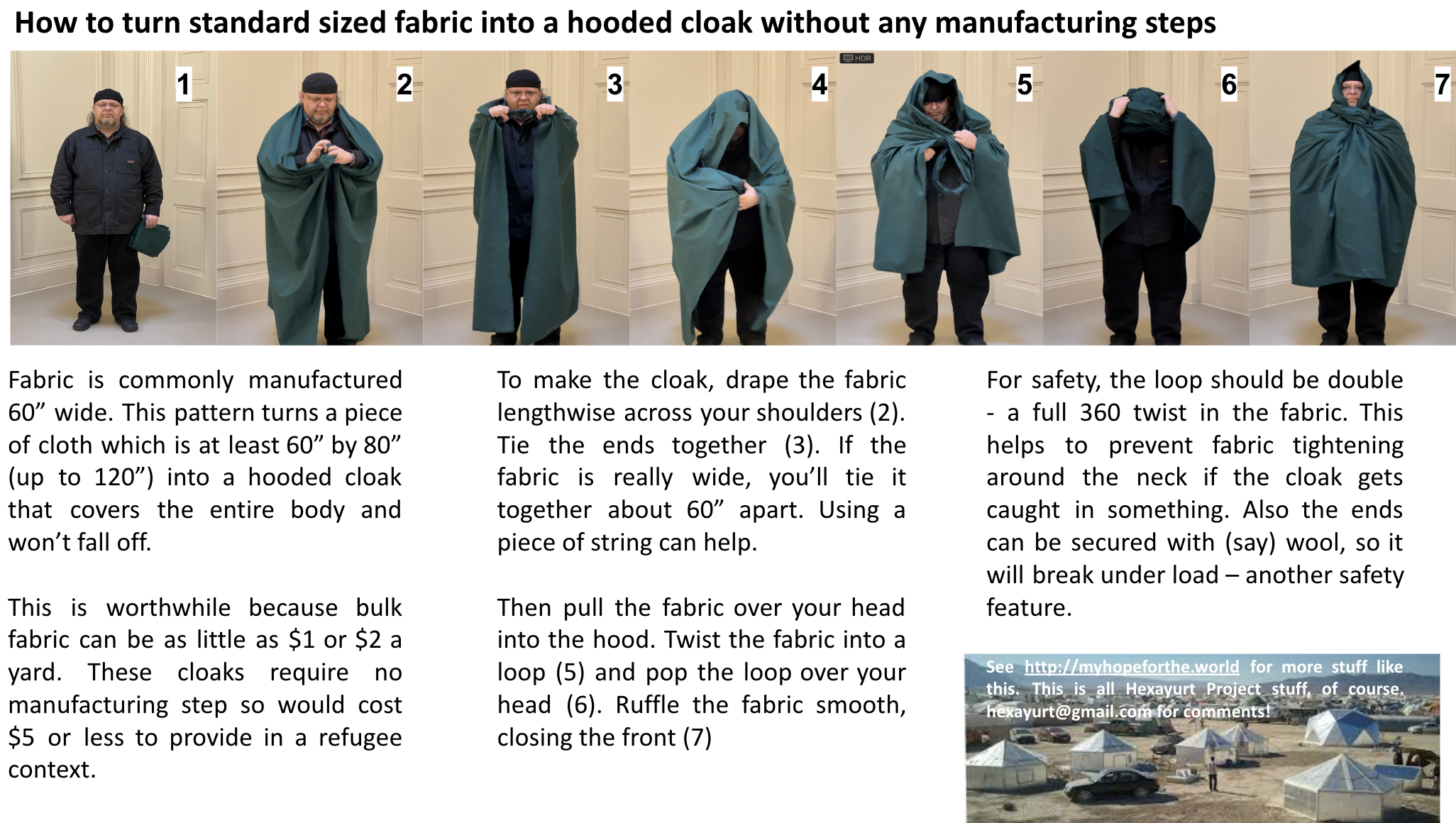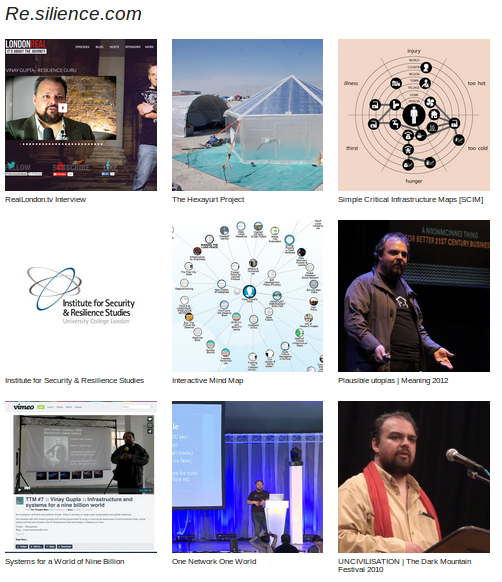Welcome!

The Hexayurt Family

We now have 13 hexayurt models which have been built and tested and are suitable for a variety of purposes. The shelters share a common feature: they can be made from standard industrial 4'x8' (1.2m x 2.4m) panels from materials like plastic, polyiso insulation, plywood, OSB, sandwich panels and cardboard. In disaster relief applications the hexayurt can cost less than a tent, and be constructed in far larger quantities than tent supplies allow.
Models by Razi Masri of Jumplogic. You can see lots of photographs of completed hexayurt builds too.
2023: still alive and kicking -- new POP UP folding hexayurt designs, and a start on clothing
First item: materials. The moop problem continues. There are much better materials than the stuff you buy in Home Depot two days before the burn but they require some work to get hold of. Please start early, use the good stuff. Your future self will thank you. So will DPW! Be kind.So about those pop-up hexayurts
Here are some amazing new designs for a folding hexayurt which can be manufactured flat, with all the seams taped, then transported into the field and put up in a single pop-up motion.The starting point for hexayurt-style clothing

There's also a design for a coat which you can get manufactured in China on-demand (long lead times, order three months before you need them). I don't make any money from this read more for details.

LA Launchpad

2017: zero moop and recyclable materials
The hexayurt has always been a zero budget project - I paid for R&D out of my own pocket, and that's often resulted in cheand nasty solutions. The polyiso board and bidirectional tape "standard hexayurt" was cooked up one summer in a hell of a hurry, and worked well enough that it became a standard, but I knew it was lousy from a sustainability perspective, and the moop problems that have developed as boards age or are badly transported are a growing problem at Burning Man as we scale from a few dozen units to a few thousand. We have to be incredibly clean, and incredibly efficient, for the hexayurt to stay part of the solution rather than becoming part of the problem.To this end, I'd like to ask you a favour: retire any hexayurt which is the least bit moopy, and replace it with something made of more durable materials, things which will last a lifetime, ideally be recycled at the end of life, and definitely, definitely will not moop at all in any stage of their lifetime. This "let us not moop" thing should be obvious, but I get the feeling that people have gotten so used to the "standard hexayurt" that they are turning a blind eye to little problems on those battered corners of a panel, or where tape has failed. Let us put a stop to that.
So what to use instead of the standard hexayurt materials? I think there's a good case to be made for sticking to tape, but moving to tapes which do not degrade in the desert sun. They do exist: more expensive, but more durable. Boards could also be fastened with metal brackets, zippers, velcro, and half a dozen other things. Do some experiments, there's 9 months until the next Burn, and this is supposed to be a collaborative R&D project: in the face of trouble, let's innovate.
Now let's talk materials. I hear great things about Thermax HD, but nobody seems to be able to source it, and it's not recyclable even if it is tough. Hunter XCI 286 seems to be about the same, but is (slightly?) easier to obtain. Honeycomb Polypropelene looks interesting, I have a few sheets kicking around at home, and there are clearly possibilities. But how well does it insulate? Industrial sandwich panels are available in an almost infinite variety of forms, that's also clearly worth further investigation.
Please, make use of the mailing list, and let's put our heads together and fix this once and for all: a new hexayurt template for the next 10 years on the Playa.
2016: total world domination
I spent most of my adult life under a vow to do nothing for money I was not willing to do for free, which led to the hexayurt, and the hexayurt being free rather than being a product. In practice this lifestyle led to me busting my ass trying to save the human race from problems that it won't admit that it has (like pandemic flu) with some pretty weird allies. I did an interview with VICE about a year ago, which detailed the decisions which led to me working with Ethereum and Consensys, largely leaving the unpaid work on disaster mitigation behind.I'm now completing that transformation by founding a venture capital project, working title hexayurt guy capital partners. We're actively looking for projects to fund, and institutions to partner with. I think you'll find the thesis interesting, and the resilience-based approach to founder psychology unique. You'd probably enjoy working with us. A lot of what pushed me down this path was watching Elon Musk's effectiveness in solving real problems using the machinery of financial capitalism. He's quite inspirational.
Even with all this going on, it's important to me that we do not lose sight of the real reasons this work exists, and why it has been free since its inception in 2002. We have made an enormous contribution to Burning Man, 2200 homes on the playa in 2015, and more this year I am sure. I hope you'll enjoy the next stages of our development. There's a Reddit AMA if you want additional insight. —VG
PS: In case you think I've entirely abandoned my efforts to improve things by diligent effort, The Cutting Machinery meditation app will be out soon, and that's another big job out of the way. If you wonder how and why I did what I did, it's in there.
Practice Safe Hex
- Finish your hexayurt at home. Definitely no board cutting, even for windows, on the Playa if you can avoid it. Reno parking lots etc. are not ideal either.
- Transport your hexayurt safely. That seems to mean sandwiching the panels between two sheets of plywood and ratchet straps if you are using a roof rack. That is going to be heavy: make sure your roof rack / car can take it!
- Make your tie downs good and strong. Candy caned rebar stakes, driven deep, or regular rebar with ends protected so nobody can cut themselves. User ratchet straps or a rope halo, and make sure it's tight enough that the wind cannot shift the unit a milimeter.
- Put a smoke detector at the peak of every hexayurt. This is really important: the more hexayurts that are in use, the safer each one must be if we are going to maintain our safety record!
- Make sure that every hexayurt has two exits. Even if one is taped shut - in case of fire. This is particularly critical if you have honeycombed hexayurts together. Fire is a real risk: please protect yourselves.

One Network, One World
Vinay Gupta, the inventor of the hexayurt, discusses the full context of the project at OHM2013, a European maker festival. Also available in ogg (230mb) via this torrent.
Welcome, Makers
Julie Danger is building hexayurts at the Maker Faire. Say hi for me!
Community Documentation
At long last, we're beginning to get some real community documentation going. Documenting the hexayurt has always been a big job, and I'm delighted to have some new resources for builders.
Julie Danger's Camp Danger folding hexayurt videos document a really easy way of making folding hexayurts. Julie's videos are by far the easiest way to understand how to make hexayurts, and highly recommended.
Then there's the Nearodesic Tridome Report by the Space Gnomes (who have more regular identities on the report). This is an incredibly useful document, with full structural engineering calculations for the Tridome hexayurt in polyiso under Burning Man conditions. I'm absolutely delighted this research has been done, and I hope you'll download it and give it a look!
George Fisher has created a survivalist's hexayurt guide (I hope he won't mind me calling it that) which is a bridge I've wanted to see built for years. I've always thought that the hexayurt was an integral part of grass roots resilience efforts in earthquake zones and similar places, and it's good to see the system percolating across cultures.
750 hexayurts at Burning Man 2012, 500 in 2011 - but how many in 2013?
Every red dot on this aerial photo from 2011 is a hexayurt. There are even more in the 2012 aerial picture but it's a little cloudy!
But we do not have an exact count for 2013 because there is no freely available high resolution satellite data. There is a satellite picture but it hasn't been released in high res yet. Ground estimates are 50% to 100% more hexayurts than 2012, which would be well over 1000 hexayurts, but until we get the satellite imagery, we just won't know for sure.

Mouseover for a look at one of the more dense areas in full res. Thanks to Jay Springett for the count!
Hexayurt Resources
- Build Instructions
Disaster relief plywood hexayurt proposal
Julie Danger's hexayurt videos
Appropedia.org/hexayurt
Community documentation - Reports and Manuals
- Physical Aspects of Distributed Infrastructure - a designers guide for ultra-low-cost solar thermal off-the-grid systems.
- Disaster Relief Shelter Design: Hexayurt Shelter Design through Material Selection and Thermal Testing by Mr Dharmesh Pankhania
- Structural Engineering Report on the Hexayurt by Mr Ben Maltby of Coventry University
- Analysis and Construction of a Nearodesic Tri-Dome (5mb pdf) by Maxwell/Suskin/Ying Yang of SAIT Polytechnic
- Concept, design & construction (18mb pdf) by George N. Fisher and on FB
- Sheltering Revisited (35mb PDF, in Dutch) by van Kinderen/Klos of Technical University of Eindhoven
- Community Documentation
- Safety
- Burning Man
Printable checklist
Construction details - H2 one person unit
- H4 tiny, easy two person unit
- H12 plywood
Hexayurt in Haiti plans - H13 polyiso
H13 plywood - Schematics for some smaller units
- Materials
Frame hexayurt - Research agenda
- Friends and Family
- Camp Danger folding hexayurt videos
- Edmund Harriss's Tri-dome and Quad-dome
- Morgan Engel's Quad-dome build
- Dylan Toymaker's hexayurt pages

The Cutting Machinery meditation app
History
Hi, I'm Vinay Gupta, the inventor of the hexayurt.
I've done some Reddit AMAs
2014
2016
Let me tell you about our project or try this quick visual overview.
2013
- For the first time, over a thousand hexayurts at Burning Man!
2012
- Hexayurt H2 one person shelter invented by Jared Warren
- Hexayurt H4 an ultra-simple easy to build small hexayurt invented by Gavin Harkness
2011
- Hexayurt Quad-Dome and Tri-Dome large domes designed by Edmund Harriss
- Camp Danger Hinge Hexayurt designed by Julie Danger
- Hexayurt Village video at Changing Tents / Burning Ice, Brussels.
2010
- Hexayurt H13 full height doorway designed by Scott Davis and Dylan Toymaker
- Hexayurt Prototype used in Haiti as part of our national response plan. Disaster hexayurt technical documentation. Wired UN Dispatch
2009
- Vinay Gupta co-authors Defence Horizons #70 with US defence intellectuals on social/digital networks and disater relief.
2008
- Hexayurt built at the Pentagon as part of the STAR-TIDES project on civ-mil cooperation during disasters.
- First ever plywood hexayurt built at Open Source Ecology
2007
- Networked Domestic Disaster Response uses hexayurts to evacuate whole cities. Well-reviewed by Red Cross and FEMA.
- Hexayurt evaluated by Netherlands Red Cross
2006
- Hexayurt featured at Strong Angel III US DOD disaster response demonstration
- Axial Temple first large scale hexayurt installation at Burning Man video
2003
- First hexayurt prototype built at Burning Man thanks to donations from Hexacomb / Pactiv, 3M, SketchUp and Innovative Energy
2002
- Vinay Gupta invents the hexayurt in response to the Sustainable Settlements Charette